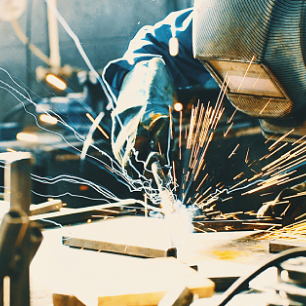Jump to:
Where Are the Welders?
Every weld starts with two materials and someone skilled enough to bring them together. Welders themselves follow a similar logic: they gather where the work demands their expertise. In 2024, WeldingWorkforceData.com estimated the U.S. welding workforce at 771,000 professionals, making welding employment a cornerstone of manufacturing, energy, and infrastructure. Over 157,000 welders are nearing retirement, while projections suggest 320,500 new welders will be needed by 2029 just to meet demand.
A close look at a map of America’s welding workforce shows that the South, Southeast, and Great Lakes regions make up roughly 60% of the workforce. The Pacific Coast, Central U.S., and Southern New England states represent 25%, while the Northern states are around 15%. This distribution tells a story about where things are still being built, and where skilled hands are shaping the country’s infrastructure and industry.
Industry Clusters: Who’s Hiring Welders — and Why
The distribution of welders across the country traces the path of industry, with clear centers of expertise reflecting where work is concentrated — and each industry has its own demands, techniques, and concentrations. Here’s a closer look at where they are and what they do.
Heavy Manufacturing & Machinery
Where they are: Midwest and Great Lakes — Ohio, Indiana, Illinois, Wisconsin.
Roles and trends: Welders in this sector handle structural fabrication, machinery frames, and industrial repair work. Robotics and automation are increasingly part of the process, but skilled welders are still essential for complex or one-off projects that require judgment and precision. These regions offer strong jobs in welding, with opportunities across both traditional and automated manufacturing environments.
Automotive & Transportation
Where they are: Michigan, Ohio, Tennessee, and Kentucky — the country’s automotive corridor.
Roles and trends: Welders here work on vehicle frames, exhausts, and assembly lines. Electric vehicle production has created new opportunities for careers in welding involving aluminum and lightweight-material welding, demanding both precision and adaptability.
Aerospace & Defense
Where they are: Southern California, Washington State, Florida, and Alabama.
Roles and trends: These welders specialize in high-precision applications using exotic alloys, titanium, and high-strength steels. Work is highly regulated, often requiring laser or electron-beam welding techniques, with strict training and certification standards. High-barrier industries like aerospace and defense provide concentrated welding employment in these specialized hubs.
Energy / Oil & Gas / Pipeline
Where they are: Gulf Coast, Texas, Louisiana, Oklahoma, North Dakota.
Roles and trends: Pipe welders keep the nation’s energy infrastructure operational — from refineries to cross-country pipelines. Work can be project-based and geographically dispersed, with strong demand for welders qualified to meet rigorous inspection and quality standards. This sector offers a variety of jobs in welding, especially for those trained in pipe and pressure system applications.
Shipbuilding & Marine
Where they are: Coastal states — Texas, Louisiana, Virginia, Maine, Pacific Northwest.
Roles and trends: Marine welders work on ships, offshore rigs, and docks, fabricating structural components and working with corrosion-resistant materials. Their expertise supports both commercial shipping and national defense, creating steady careers in welding along the nation’s coasts...
Infrastructure & Construction
Where they are: Nationwide, with concentration in Texas, Florida, New York, and California.
Roles and trends: Bridge welders, ironworkers, and structural fabricators are essential for public works projects and large-scale construction. Federal infrastructure investment has increased demand, highlighting the critical role of welding in maintaining and expanding the nation’s-built environment. These regions provide abundant welding employment opportunities.
According to the Bureau of Labor Statistics, 61% of welders work in manufacturing, followed by specialty trade contractors (8%) and repair/maintenance (4%). High-barrier industries such as aerospace, defense, and energy tend to cluster in specialized hubs with advanced training and inspection facilities. Meanwhile, welders in mass manufacturing keep industrial centers in the Midwest and South productive.
Technology is reshaping the field, too. Robotic and automated welding systems are becoming standard, but welders remain essential — now often in hybrid roles, combining hands-on skill with programming, calibration, and oversight of robotic operations.
The picture that emerges is clear: welders are concentrated where skill meets demand. Their distribution reflects the country’s industrial heartbeat, highlighting the industries that are thriving and those that depend on a new generation of skilled welders to keep building, repairing, and innovating.


